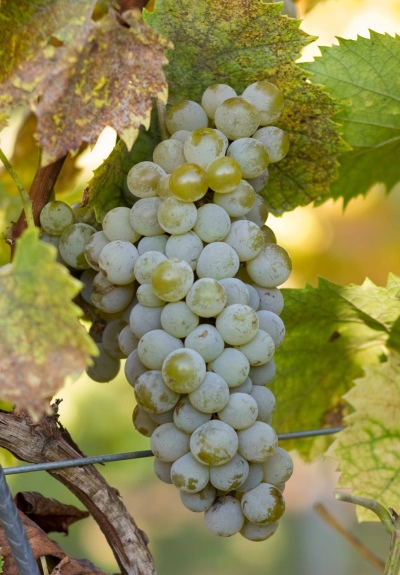
- Authors: VNIIViV them. ME AND. Potapenko. Authors - Ya.I. Potapenko, L.I. Proskurnya, A.S., Skripnikova
- Appointment: technical
- Berry color: amber, with a strong waxy coating
- Taste: harmonious, nutmeg
- With bones: Yes
- Ripening period: mid-late
- Ripening period, days: 145
- Frost resistance, ° C: -25
- Bunch weight, g: 118-150
- Yield: 80 c / ha
Flower grapes have been a success among gardeners for more than 30 years. It is resistant to fungal diseases and low temperatures, and juices and wines made from its fruits have an exquisite rich taste.
Breeding history
The Flower grape variety was bred by the specialists of the Novocherkassk All-Russian Research Institute of Life Sciences named after Ya. I. Potapenko: Ya. I. Potapenko, L. I. Proskurnya, A. S. Skripnikova. The hybrid was obtained by crossing Northern grapes with pollen of the varieties Hungarian Muscat, White Muscat, Alexandrian Muscat. Then the new grape was tested under certain conditions, and in 1988 it was approved for use as an independent hybrid.
Description
This technical variety is characterized by undersized shrubs with above average vigor. Leaves are medium in size, rounded, five-lobed with medium-deep dissection; young leaves are green and pubescent. The notch of the petiole is lancet and deep. The one-year mature shoot is thin, has a yellowish-brown color and dark nodes. The flowers of this hybrid are bisexual.
Ripening period
Floral belongs to the mid-late varieties. In general, the ripening period is 145 days. In warmer climates, for example, on the territory of Ukraine, it can ripen in 134 days. The sum of all active temperatures from the beginning of budding to technological maturity is 3600 degrees. For use in winemaking, it fully matures by mid-September.
Bunches
The bunches of the Tsvetochnyi variety are characterized by an average density. They are cylindrical-conical in shape. One bunch weighs 118-150 g. The hybrid has a predisposition for peas, which means that the grapes can be of different sizes. The number of clusters per shoot is 0.7.
Berries
The grapes are round, amber in color, with a strong waxy bloom. Berries of the Flower variety are medium-sized. They are characterized by juicy pulp, in which there are rather large bones. The skin, like all technical varieties, is firm but thin.
Taste
The fruits have a harmonious, nutmeg taste and aroma. The sugar content is 233 g / dm3. Acidity - 10.3 g / dm3. It can be eaten fresh, but basically, like all technical varieties, it is grown for the production of juices and wine. Wine tasting evaluation:
- dining room - 8 points;
- dessert - 8.5 points;
- sparkling wine - 9 points.
Yield
The flower grape belongs to medium-yielding varieties. Its yield is 80 c / ha. The percentage of shoots with fruits is 58.


Growing features
Not a very difficult hybrid in culture. But you should know that the Tsvetochny variety prefers soils with good irrigation or with a close location of groundwater. Drought is fatal for its shoots.
Landing
It is recommended to plant flower grapes in the soil in spring without applying any fertilizers, as they can affect the taste of the wine. As a support, you can use the simplest single-plane trellis. In the southern regions, forming on a high stem is used. The landing site should be sunny and protected from strong winds.

Pollination
The Floral hybrid is characterized by bisexual flowers. This means that they self-pollinate and do not require additional pollination. This variety blooms, as a rule, by the beginning of June. There should be no more than 0.7 flower brushes for a young shoot, and 1.4 for an adult.
Pruning
Mandatory sanitary pruning of dry and diseased shoots in the fall is practiced. In the spring, pruning is carried out in order to form a fruitful vine. In the Flower variety, it is recommended to leave 4-6 eyes on the shoot. The bushes should be not thickened, well ventilated and lighted.



Frost resistance and the need for shelter
This hybrid can withstand winter frosts down to -25 degrees. But young shoots must be covered with straw, sawdust or spruce branches. Adult bushes, even with severe freezing, recover well in the spring and summer.

Diseases and pests
Flower grapes do not attract pests. Resistance to mildew (downy mildew) is 3 points. But it weakly resists powdery mildew and gray rot.
When oidium is damaged, spots and grayish-white bloom appear on the leaves and buds, the whole plant is as if sprinkled with flour. For prophylaxis, plants must be treated with powdered sulfur and fungicides. Humidity and coldness contribute to the appearance of gray mold. Grape shoots turn brown and die. For preventive purposes, it is recommended to treat the bushes with fungicides 4 times per season.

If a grape is exposed to any disease or insect, this always affects its appearance.
Storage
As you know, technical grape varieties are not suitable for long-term storage. The Flower variety is no exception. He also does not tolerate long transportation.











































































